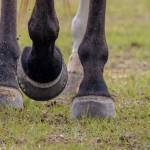Wet Feet: Nutritional Management of Horses in Water-Logged Areas

When soggy weather prevails, you may not ride your horse as often as you’d like, which means you may not be observing the subtle changes associated with chronically wet hooves and legs.
Obviously, the requirements for a balanced ration do not change during inclement weather, but intake is based on workload, so modifications might be necessary. If your horse is stabled or yarded and cannot be ridden because of bad weather or soggy surfaces, reduce its hard feed by up to half, but ensure adequate fibre and nutrients are met by increasing hay and feeding a vitamin and mineral supplement. Appropriate science-based vitamin and mineral supplements include Gold Pellet, Perform, or Nutrequin Se, all offered by Kentucky Equine Research. For horses that have protein requirements beyond the forage source, choose a balancer pellet like All-Phase. Supplying appropriate amounts of vitamins and minerals can help prevent problems caused by overfeeding and underworking such as behaviour changes, laminitis, tying-up, and colic.
Remember some horses will turn up their noses at wet hay, so hang haynets in a shelter or use a covered hay feeder to prevent wastage.
Horses kept in wet paddocks will have softer hooves. In addition to changes in shape—wet hooves often become flared and flat-soled—consistent wetness may predispose hooves to cracks, bacterial infections (thrush, white line disease), and abscesses. In short, the wetter hooves becomes, the less structural integrity they have.
A little-known problem among horses with chronically wet hooves is a problem known as retracted soles. Thin-soled horses that stand in wet conditions over time are predisposed to this problem, as the moisture weakens the sole, pushing it upward into the coffin bone and causing pain. Horses with retracted soles are often more comfortable walking on hard surfaces than soft surfaces, which distinguishes this condition from many other hoof-related problems.
These problems may be more pronounced if horses are in negative energy balance or consume insufficient quantities of essential hoof-building nutrients, such as protein and zinc. In these cases, a research-proven hoof supplement can help keep your horse’s feet strong and healthy and will also help maintain skin and coat health.
For horses that need a higher level of hoof-related nutrients, Kentucky Equine Research offers Bio-Bloom HF to provide additional support for hoof quality and growth. If possible, clean your horse’s feet regularly, removing all mud from the hoof and lower legs. Trim feathers to avoid scratches and risk of mud fever. Scratches can be difficult to manage and often require above-and-beyond care. One way to handle scratches is through supplementation with EO-3, a marine-derived source of omega-3 fatty acids.
Even though your horse should lose fewer electrolytes in sweat, due to reduced workload, some horses with longer coats can sweat profusely in winter, especially when worked if they are not clipped. A salt block in the paddock or loose salt in the feed is essential, and many working horses need an electrolyte year-round. Kentucky Equine Research recommends the use of Restore and Restore Paste, scientifically formulated electrolyte supplements designed to match the composition of sweat.








